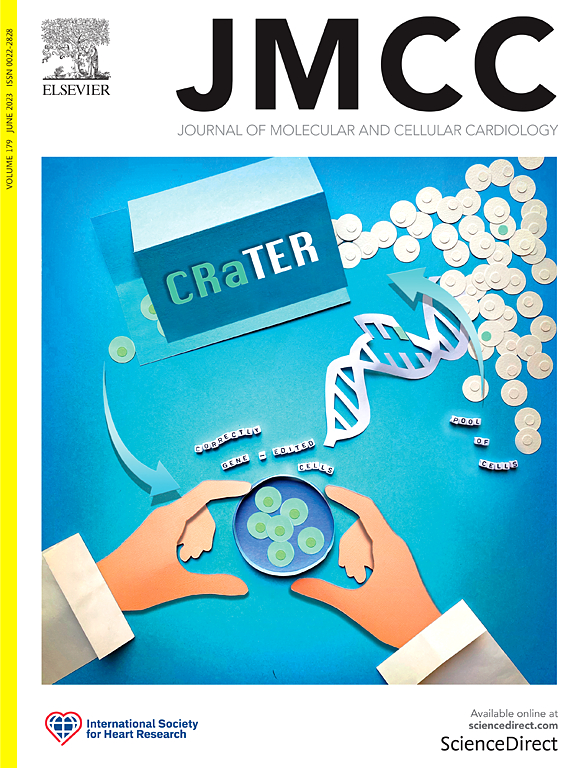ttntv心肌病的营养反应失调可以通过Erk抑制来修复心脏保护作用。
IF 4.7
2区 医学
Q1 CARDIAC & CARDIOVASCULAR SYSTEMS
引用次数: 0
摘要
背景:截断TITIN变异(TTNtv)是扩张型心肌病(DCM)最常见的遗传原因;然而,关键的病理信号通路仍然难以捉摸。我们最近建立了斑马鱼TTNtv DCM模型,并开发了一种基于f0的基因组编辑技术,用于快速筛选遗传修饰因子。方法:我们使用斑马鱼ttntv DCM模型,通过基于f0的遗传分析筛选多种已知的心肌病信号通路。由于ERK信号是通过筛选确定的,并且在ttntv DCM模型的心脏转录组学研究中也独立地确定了ERK信号通路的改变,因此我们随后评估了差异表达基因(DEGs)对ERK信号的修饰作用。结果:erk1和mek1已被确定为ttntv DCM的治疗调节剂。与它们的修饰作用一致,我们在ttntv成年斑马鱼中观察到磷酸化Erk1蛋白水平升高。在机制上,我们发现ERK信号的增强导致营养反应的失调,正如在禁食-再进食周期中,心脏中磷酸化核糖体蛋白S6 (pS6)表达的沉默反应所表明的那样。抑制ERK信号传导足以挽救失调的营养反应和减轻心功能障碍。对ERK信号传导中DEGs的进一步遗传筛选发现,ppp1r10编码蛋白磷酸酶1 (PP1)调控亚基,调控Mek1/Erk1磷酸化,是另一个治疗修饰基因,也可以挽救不受调节的营养反应。结论:ttntv心肌病中Erk -营养反应信号轴被破坏,可通过抑制erk1、mek1或ppp1r10修复,为ttntv DCM提供了新的治疗途径。本文章由计算机程序翻译,如有差异,请以英文原文为准。

Deregulated nutrient response in ttntv cardiomyopathy can be repaired via Erk inhibition for cardioprotective effects
Background
Truncating TITIN variants (TTNtv) are the most prevalent genetic cause of dilated cardiomyopathy (DCM); however, key pathological signaling pathways remain elusive. We recently established a zebrafish model of TTNtv DCM and developed a F0-based genome editing technology for the rapid screening of genetic modifiers.
Methods
We screened multiple known cardiomyopathy signaling pathways through a F0-based genetic assay using a zebrafish ttntv DCM model. Because ERK signaling was identified from the screen, which was also independently identified as an altered signaling pathway during a cardiac transcriptomic study of the ttntv DCM model, we then assessed modifying effects of differentially expressed genes (DEGs) in ERK signaling.
Results
erk1 and mek1 have been identified as therapeutic modifiers for ttntv DCM. Consistent with their modifying effects, we observed increased levels of phosphorylated Erk1 protein in ttntv adult zebrafish. Mechanistically, we showed that enhanced ERK signaling results in deregulated nutrient response, as indicated by the muted response of phosphorylated ribosomal protein S6 (pS6) expression in the heart during the fasting-refeeding cycle. The inhibition of ERK signaling is sufficient to rescue deregulated nutrient response and mitigate cardiac dysfunction. Further genetic screens of DEGs in ERK signaling identified ppp1r10, encoding a protein phosphatase 1 (PP1) regulatory subunit that regulates Mek1/Erk1 phosphorylation, as another therapeutic modifier gene that also rescues deregulated nutrient response.
Conclusions
An Erk - nutrient response signaling axis is disrupted in ttntv cardiomyopathy, which can be repaired by the inhibition of erk1, mek1 or ppp1r10, suggesting a new therapeutic avenue for TTNtv DCM.
求助全文
通过发布文献求助,成功后即可免费获取论文全文。
去求助
来源期刊
CiteScore
10.70
自引率
0.00%
发文量
171
审稿时长
42 days
期刊介绍:
The Journal of Molecular and Cellular Cardiology publishes work advancing knowledge of the mechanisms responsible for both normal and diseased cardiovascular function. To this end papers are published in all relevant areas. These include (but are not limited to): structural biology; genetics; proteomics; morphology; stem cells; molecular biology; metabolism; biophysics; bioengineering; computational modeling and systems analysis; electrophysiology; pharmacology and physiology. Papers are encouraged with both basic and translational approaches. The journal is directed not only to basic scientists but also to clinical cardiologists who wish to follow the rapidly advancing frontiers of basic knowledge of the heart and circulation.

 求助内容:
求助内容: 应助结果提醒方式:
应助结果提醒方式:


